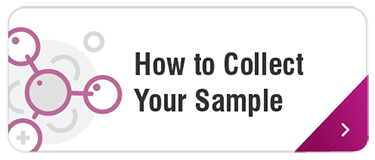Collecting a blood spot, saliva or urine sample is easy and convenient and can be done in your doctor's office or at home on your own schedule. We encourage you to watch our Collection Videos detailing how to correctly use our test kit to get a good sample for us to test. Below you will see questions and answers to our most frequently asked questions about the collection process.
Men can collect at any time of the month.
Women who:
- Do not have menstrual cyclescan collect any day. This would include women with hysterectomy, amenorrhea (abnormal absence of menses in women of reproductive age) and/or uterine/endometrial alblation (destruction of the uterine lining).
- Have 'normal' menstrual cyclesshould collect day 19, 20 or 21 (counting the 1st day of bleeding as day 1)
- Have irregular, unpredictable menstrual cyclescan collect any day they are not bleeding.
- Have some kind of cycle regularity but not at the typical lengths should follow these guidelines for collection: Long cycles – test at day 19-21 or from day 19 to 5 days prior to when the period is expected. For example, if the cycle is 35 days, collection can be done anytime between day 19 to day 30. Short cycles – collection should be done a couple of days prior to when bleeding starts. For example, someone with 14 day cycles should collect on day 12.
While vitamins may improve your symptoms, they do not generally change lab results. However, please list all hormones, supplements and vitamins that you are taking on your requisition form.
The following products are available over-the-counter and may affect lab results (this is not an exhaustive list): progesterone, pregnenolone, DHEA, 7-Keto-DHEA (see special notice), hydrocortisone (cortisol). Continue to use topical hormones daily as prescribed, but avoid applying them to the face and neck areas for 3 days prior to testing. Rub in topical hormones without using fingers (e.g. wrist to wrist) for at least 2 days prior to collection. Skip use of anti-aging creams that may contain hormone traces.
NOTE: 7-Keto-DHEA is a variant form of DHEA and can create false elevations of DHEA and testosterone test results. Please discontinue use of sublingual 7-Keto-DHEAS for 3 days prior to testing. If using pill form, follow the oral collection instructions.
Do NOT stop current hormone therapy prior to collection. Continue to use hormones daily as usual and follow the guidelines below for optimal timing of collection.
Hormone type sample collection guidelines:
- Pills, Gels, Creams, Sprays (oral, topical*, vaginal): 12-24 hours AFTER last dose – do not apply to face or neck
- Sublinguals and Troches (dissolve under tongue): Saliva testing is not appropriate for sublingual hormone users because of direct contamination. Blood spot testing is the preferred option for these patients.
- Patches: 1-2 days after applying patch
- Injections/Pellets: Midpoint between injection/pellet inserts
The following also qualify as hormones (not limited to):
Birth control, melatonin, hydrocortisone, steroid injections, flonase, prednisone, creams containing pregnenolone, placental derivatives or stem cells. If using any of these, collect as above.
If you collect outside the recommended time frame above, this may result in hormone levels lower or higher than ZRT reference ranges for hormone users.
Topical hormones, please note:
- Do NOT use bare hands for topical hormone application for at least two days prior to saliva collection (apply hormones using latex gloves or preferably hormone-loaded syringe or applicator).
- Do not apply hormones to face or neck. Apply hormones to areas of the body that can be covered by clothing to avoid transfer of hormones from fingers to face, lips, or mouth.
- Wash hands thoroughly with soap and water after each application of hormones and dry with clean towel.
- False-high saliva results can result when hormones from contaminated surfaces (faucets, counters, door knobs) or towels are transferred inadvertently from fingers/hands and then to face, lips, or mouth.
Since oral contraceptives suppress ovarian hormone levels, timing of the sample collection is less important. If you are discontinuing oral contraceptives, allow for withdrawal bleeding and wait until your next spontaneous cycle to test. Collect sample on day 19-21 of your cycle.
Yes. Discontinue anti-wrinkle creams at least 3 days before collection. You may substitute moisturizing creams that are safe for infants during the three days.
No. You should wait until you are healthy before collecting.
Saliva testing for DHEA-S and cortisol as well as blood spot testing for thyroid, Vitamin D, and CardioMetabolic markers is definitely beneficial for women taking oral birth control pills. Collect your sample on day 20 of your cycle, counting your first day of bleeding as day 1.
Please note, if you and your medical professional decide to discontinue your oral contraceptives, you should wait until your next menstrual period to collect. It may take approximately 7 weeks before you are able to collect your sample after discontinuing the pill as failure to ovulate is common in many women immediately after discontinuing birth control pills.
Within 30 minutes of waking, collect a few drops of blood from a quick and nearly painless nick of the finger (using the kit enclosed lancets) on a ZRT collection card. Once collected, allow your blood spot samples to dry for half an hour and then send them back to ZRT for processing. For more information, please watch the Collection Video, refer to the Collection Instructions included in your kit or read the Blood Spot FAQs.
You should collect your sample within 30 minutes of waking prior to eating, drinking, exercising, flossing or brushing your teeth, or taking hormones. For more information, please watch the Collection Video, refer to the Collection Instructions included in your kit or read the Saliva FAQs.
To ensure accurate results, all tubes should be at least ½ full (preferably ¾ full) excluding bubbles.
The large test tube, when filled ½ to ¾ full, can test the following hormones: estradiol, estriol, estrone, progesterone, testosterone, DHEA-S, and morning cortisol.
The small tubes are used for those testing more than one cortisol level. To perform a complete adrenal function test, cortisol is collected four times throughout the same day (morning, noon, evening, and at bedtime).
If you are having difficulty collecting saliva, we have a few recommendations:
Note: Too many bubbles are often caused by spitting too frequently into the tube. To avoid bubbles, try pooling saliva in your mouth for several minutes before spitting. If your sample contains a large percentage of bubbles, cap the tube and tap it on a hard surface to disperse bubbles into liquid.
- Drink extra water the day/night before collection to encourage the production of more saliva.
- If your mouth is dry, try pressing the tip of your tongue against your teeth or the roof of your mouth. Smelling (not eating) a lemon or other foods can also produce saliva flow.
- Allow saliva to pool in mouth before collecting.
- Chewing gum (even sugarless) is not advised as it may contaminate the sample.
- If you are still unable to collect enough saliva in one day, cap the tube, place in the refrigerator or freezer, and add more saliva at the same time the next day until the tube is at least half full. You may continue collecting in this way for up to 3 days.
Yes. You should begin collection the next morning. Just rinse the tube with warm water (no soap), allow to air dry, and collect within 20-30 minutes after waking and before eating, drinking, brushing or flossing your teeth.
Collection should be done on a day when you are engaging in your normal, routine activity. Any exercise will affect cortisol levels. Therefore, if you routinely engage in strenuous exercise and want to see what happens to your cortisol with exercise, then testing on that day is acceptable. However, if you do not routinely exercise or do not wish to see the effect of exercise on your cortisol levels, refrain from vigorous exercise (e.g., running, biking, etc.) on the day of testing.
People with diabetes who are doing saliva testing should discuss this question with their medical professional. If you do choose to eat before collecting your sample, cortisol levels will be affected. In any case, it is always important to rinse your mouth prior to collecting your saliva. Do NOT brush your teeth prior to collecting as this may cause micro-bleeding in your mouth that could change sex hormone results.


